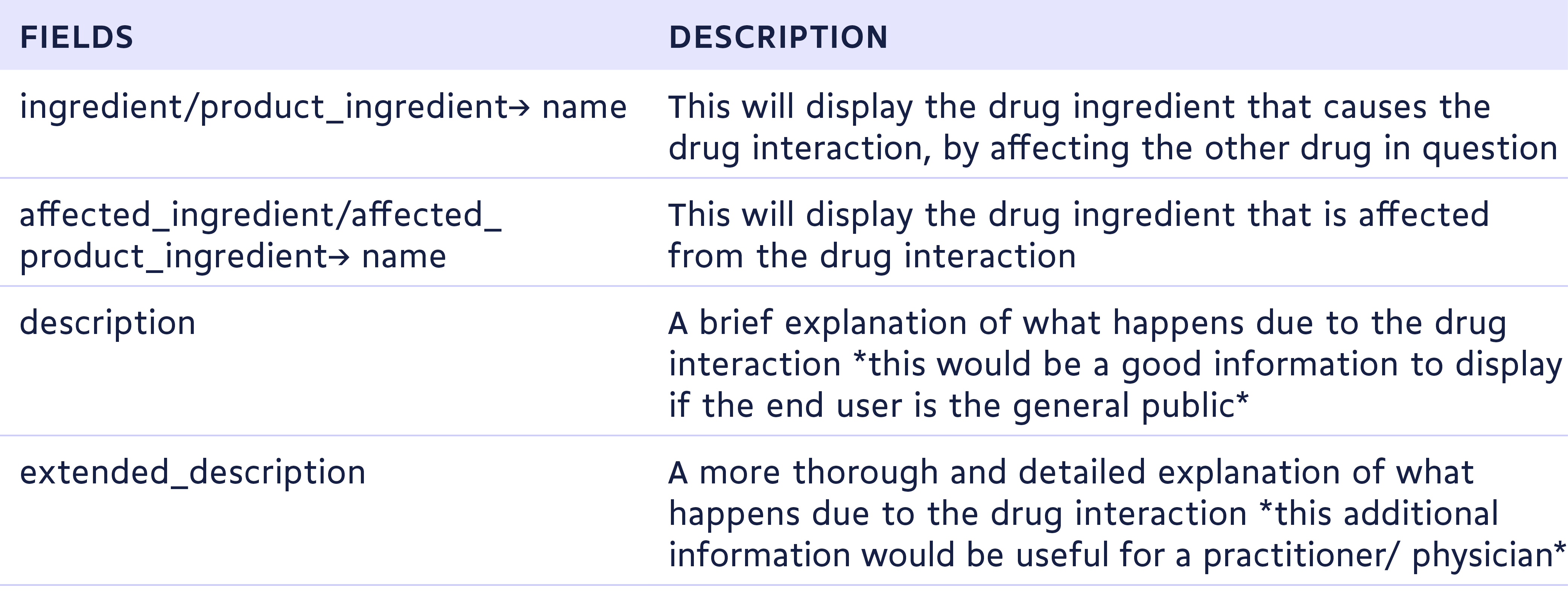Leverage DrugBank's Clinical API with the Drug-Drug Interaction Checker
Get started with our Drug-Drug Interaction Checker and explore everything our Clinical API has to offer

The Drug-Drug Interaction checker can quickly search over 1.3 million interactions, allowing you to search by a variety of identifiers. It's one of the best tools to bring your product to the next level. Discover the best ways to integrate with our implementation guide below.
Looking for a different way to use the Clinical API? Discover all the implementation guides in the series.
Table of Contents
- How Does the Drug-Drug Interactions Checker Work
- Drug-Drug Interactions Plug and Play
- What are Interactions
- Get Started
- Must Knows
- Good to Knows
How does the Drug-Drug Interactions Checker work?
DrugBank’s DDI module and endpoints can be tailored for any application whether the end user is a healthcare professional or the general public.
Let’s take a look at a scenario where the DDI checker can be used:
A Physician has a patient that has a recent diagnosis of atrial fibrillation and is currently being treated with Coumadin (blood thinner), as well as a past medical history of urinary tract infection (UTI). She once again presents with symptoms of a UTI. In the past, her Physician had prescribed Bactrim to treat her UTI; however, with her current medical condition requiring warfarin use, the Physician checks possible drug-drug interactions in order to prevent complications. The DDI checker the Physician uses in the clinical software is powered by the DrugBank DDI API, which returns interactions between Coumadin and Bactrim. . The Physician confirms that in this instance, Bactrim along with the patient’s blood thinner increases the risk for excessive bleeding and can now look for a safer alternative treatment.
Drug-Drug Interactions Plug and Play
We’ve created a ready-to-use plugin that makes showing drug-drug interactions a breeze! Not only does it integrate well with our Medication Search Plugin, but it’s also easy to add it to any healthcare software where users need to check for drug interactions. It’s beautifully designed and ready for you to start using in mere hours!
Download the Plugin with a detailed implementation guide.

What are Interactions?
DrugBank’s Drug-Drug Interactions (DDI) endpoints check for interactions between ingredients of specified drug products. Leveraging this information is beneficial to users because it helps them to make informed decisions about whether certain drugs should or should not be taken together, and other important factors such as risks associated with using drugs in certain combinations. This helps increase better medication outcomes, reduce medical errors and patient morbidity.
At DrugBank, we group our drug interactions in 3 ways:
1. Drug-Drug
This interaction is generated when there is a known interaction specifically between two specific drug ingredients.
2. Drug-Category
This type of interaction is between a drug ingredient and an entire category of drugs. Drug ingredient A is known to interact with a specific category of drugs. Essentially, any drugs that are grouped into the specified category that drug A will interact with will result in an interaction being created.
3. Category-Category
Our drugs are assigned to specific categories based on, but not limited to, the drug class, targets, mechanism of action, physiological properties, adverse effects, and other relevant pharmacokinetics and pharmacodynamics information.
Drug interactions created through a category-category source interaction originate because a specific drug category is known to have an effect when it interacts with another specific drug category. It is the categories that the drugs are grouped into that create these additional interactions not found specifically on the drug label.
Learn more about the 3 types of drug interactions.
Get Started
To get started with the DDI endpoint, you will first need to capture a minimum of two assigned IDs. The IDs can be a combination of the following:
- Active ingredient using DrugBank ID (DB ID)
- Drug product using DrugBank Product Concept ID (DBPC ID)
- Local product IDs such as an NDC code
To learn more on obtaining the various IDs check out these articles:
DrugBank IDs
DrugBank Product Concept IDs
Local product IDs
NOTE: We recommend using Product Concept IDs since this allows you to check for interactions taking routes into consideration. For example, when 2 drugs interact and are taken orally, but do not interact if one is topical and the other is oral.
Step 1: After grabbing the stored IDs, you can now start the drug-drug interactions check. You would enter the following base URL:
https://api.drugbank.com/v1/ddi?Step 2: How to use the drug-drug interactions check
Let’s go back to the story above and show how the DDI endpoint works using the recommended method with Product Concept IDs. The two products mentioned in the story are Coumadin (DBPC0062768) and Bactrim (DBPC0043651).
After the base URL you would add the following parameter:
https://api.drugbank.com/v1/ddi?product_concept_id=DBPC0062768,DBPC0043651By using the Product Concept search, the combined characteristics of the drug products, in this case, Coumadin and Bactrim, are searched. Notice on line 5 that the 2 drugs that make up Bactrim (sulfamethoxazole and trimethoprim) are both listed. These are broken down separately in lines 8 and 30. The interactions check will take into account both of these components, combined and separate, against the 2nd drug product, Coumadin. Notice on line 11 that Coumadin is identified as the brand, and the ingredient is warfarin.

As with the previous example, any interactions between some or all of these ingredients will be listed in a summary description as well as an extended description, along with management if any interactions exist.
NOTE: in this case, we used a Product Concept ID, but you can use other identifiers in a combination or by themselves as long as the API is given specific identifiers. For example, the equivalent of using other IDs would be:
- For drug ingredients: https://api.drugbank.com/v1/ddi?drugbank_id=DB00682,DB00196
- For NDC codes: https://api.drugbank.com/v1/ddi?ndc=55154-7716,49708-0145
- For a combination: https://api.drugbank.com/v1/ddi?product_concept_id=DBPC0024484&drugbank_id=DB00503&ndc=0143-9503
Must Knows
Two parameters from the DDI endpoint are especially noteworthy: severity and evidence.
Severity is grouped into 3 levels: minor, moderate, and major. Filtering at a specific severity level may be helpful depending on your use case. Likewise, the evidence parameter can help you determine if an interaction should be displayed. You may only want to display interactions documented on a drug label (evidence level 1) vs. interactions that have been reported in case study (evidence level 2).
Since many drug-drug interactions exist, these two parameters help filter interactions based on your specific needs without overwhelming you with extraneous data.
Here’s a breakdown of the different parameters and the descriptions of the results:
Good To Knows
Drug-drug interactions endpoint can check up to a maximum of 40 drugs per call.
You may also have mixed input IDs for the drug interaction checker (eg. DB IDs & product concept IDs combo, DB IDs & local product IDs combo, product concept IDs & local product IDs combo, or a combo of all three).
DrugBank covers multiple regions, and each jurisdiction has its own unique product ID field.
Here is a list of the different codes that can be used when applying the local product ID method for an interaction search:
Depending on your use case, you might not require everything returned from the interaction search. Here are a few common fields that are valuable:

No matter your use case, our Clinical API provides a range of powerful tools to help you bring more certainty and speed to you and your user’s day. Depending on your specific needs it’s a good idea to explore a variety of DrugBank's options to find the right module for you. Our customer success team has the know-how and experience to help you identify what will work best for you and guide you along the way as you get up and running.


